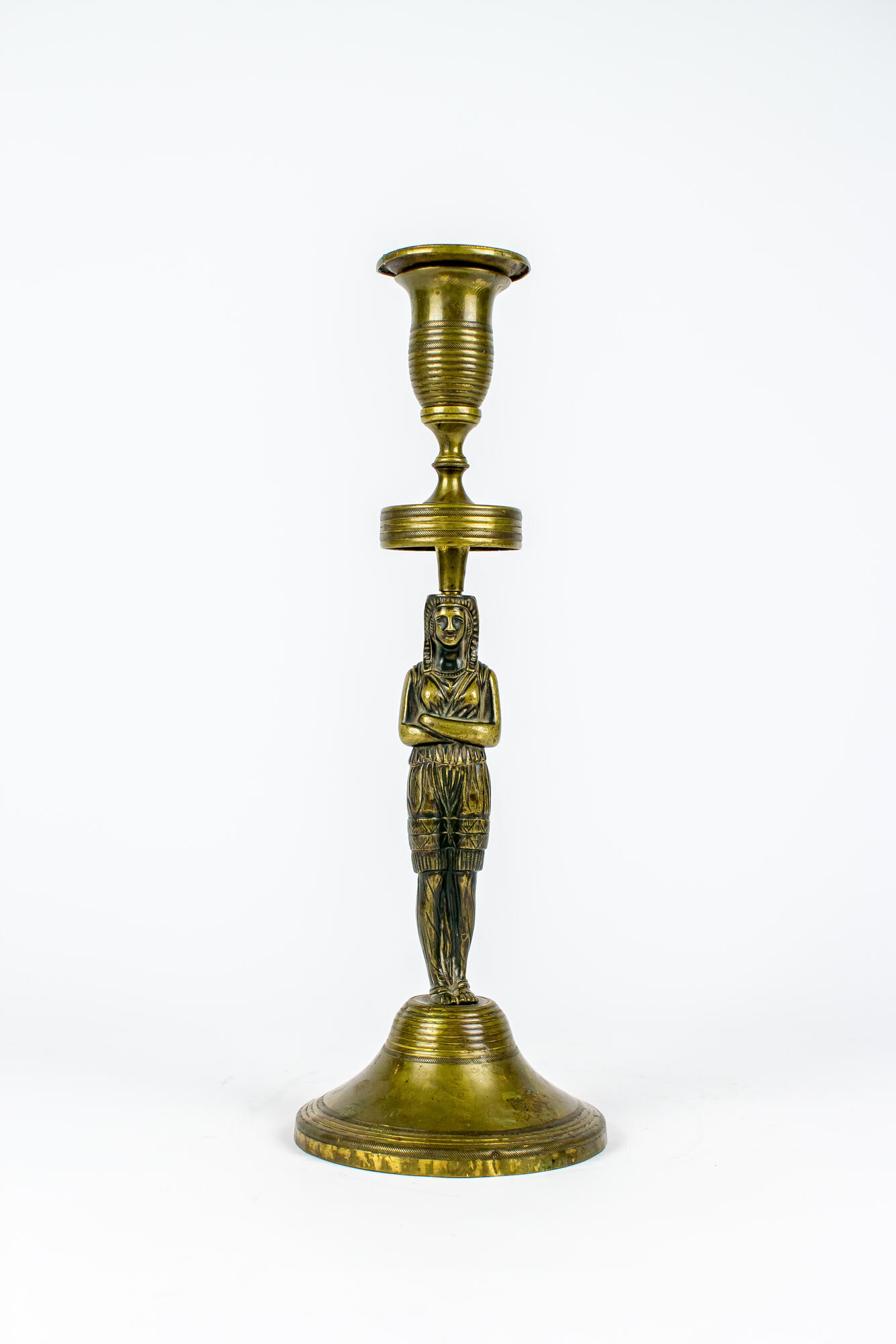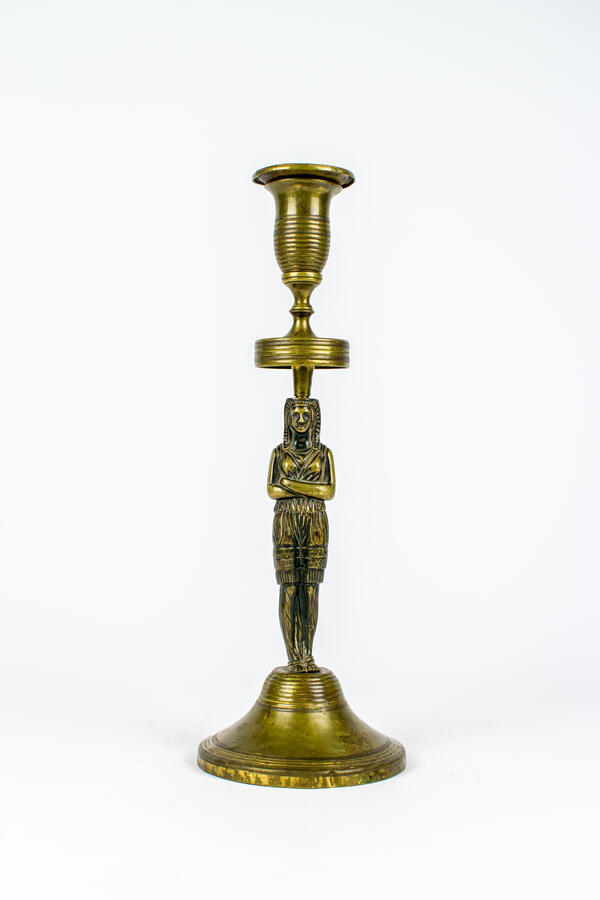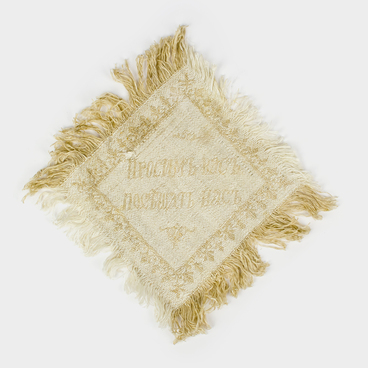The figural candlestick in the Egyptian style is made in the form of a woman standing with her arms crossed. The round copper stand of the product is filled with plaster from below for balance. A candle socket in the form of a bowl with a plate bolted on top is attached to the woman’s head.
Interest in the subjects of ancient Egyptian mythology and Egyptian traditional art has arisen in world culture repeatedly. For the first time, Egyptian subjects were copied by masters in ancient Rome. But the art of the ancient Egyptians gained special popularity in the late 18th — early 19th centuries, when the Egyptian campaign of Napoleon Bonaparte rediscovered Egypt for Europe.
The Egyptian style was characterized by the stylization of decorative elements and the use of ancient Egyptian art motifs: obelisks, sphinxes, lotus flowers and papyrus, hieroglyphs. The masters created sculptures of sacred animals and mythological characters: cats, sphinxes, griffins and scarabs. Inlaid statues were often placed in wall recess.
In the rooms designed in the Egyptian style, the walls were covered with frescoes on the afterlife theme. Columns with ornaments and capitals in the form of lotus flowers divided the interior into naves. Architects often used sapphire color and golden jewelry. The interior was decorated with light marble, and wooden details, such as furniture, were chosen in dark shades.
Egyptian motifs were an integral part of the Empire style. In Russia, they became popular during the early Alexander classicism of the early 19th century, as well as in the era of the Russian, or Nicholas, Empire. In the 18th–19th centuries in St. Petersburg and the suburbs, stylized elements of ancient Egyptian motifs were actively used in the design of buildings, bridges, and interiors of palaces. For the first time, Egyptian images penetrated into Russian art even under Peter the Great, when the “Pyramid” fountain was installed in Peterhof on the initiative of the emperor himself.
Famous European masters of decorative and applied art used Egyptian motifs: a furniture maker Georges Jacob Sr. and a bronze worker Pierre-Philippe Tomir. Since 1805, Tomir was the “court coiner” of Napoleon Bonaparte, he made bronze furniture parts, chandelier, tripods, vases and watch cases. Characteristics of the Empire could be traced in the products of his workshop such as a combination of Roman and Egyptian motifs, mahogany and gilded bronze, as well as patinated, matte-black bronze, which was associated with the basalts of Egypt. Painters and sculptors-designers of the famous Sevres porcelain manufactory used Egyptian images.
Interest in the subjects of ancient Egyptian mythology and Egyptian traditional art has arisen in world culture repeatedly. For the first time, Egyptian subjects were copied by masters in ancient Rome. But the art of the ancient Egyptians gained special popularity in the late 18th — early 19th centuries, when the Egyptian campaign of Napoleon Bonaparte rediscovered Egypt for Europe.
The Egyptian style was characterized by the stylization of decorative elements and the use of ancient Egyptian art motifs: obelisks, sphinxes, lotus flowers and papyrus, hieroglyphs. The masters created sculptures of sacred animals and mythological characters: cats, sphinxes, griffins and scarabs. Inlaid statues were often placed in wall recess.
In the rooms designed in the Egyptian style, the walls were covered with frescoes on the afterlife theme. Columns with ornaments and capitals in the form of lotus flowers divided the interior into naves. Architects often used sapphire color and golden jewelry. The interior was decorated with light marble, and wooden details, such as furniture, were chosen in dark shades.
Egyptian motifs were an integral part of the Empire style. In Russia, they became popular during the early Alexander classicism of the early 19th century, as well as in the era of the Russian, or Nicholas, Empire. In the 18th–19th centuries in St. Petersburg and the suburbs, stylized elements of ancient Egyptian motifs were actively used in the design of buildings, bridges, and interiors of palaces. For the first time, Egyptian images penetrated into Russian art even under Peter the Great, when the “Pyramid” fountain was installed in Peterhof on the initiative of the emperor himself.
Famous European masters of decorative and applied art used Egyptian motifs: a furniture maker Georges Jacob Sr. and a bronze worker Pierre-Philippe Tomir. Since 1805, Tomir was the “court coiner” of Napoleon Bonaparte, he made bronze furniture parts, chandelier, tripods, vases and watch cases. Characteristics of the Empire could be traced in the products of his workshop such as a combination of Roman and Egyptian motifs, mahogany and gilded bronze, as well as patinated, matte-black bronze, which was associated with the basalts of Egypt. Painters and sculptors-designers of the famous Sevres porcelain manufactory used Egyptian images.



